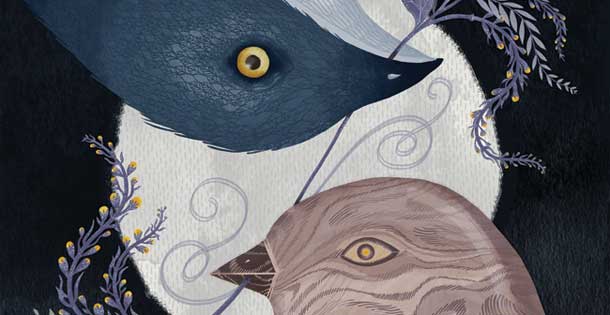SILAS FOUND WAYS to remain true to all of James’ suspicions. He was largely indefinable. He didn’t make friends easily, or at all, and regardless of how much work James put on him he still read too many books and developed one too many odd habits. He ate his plate clockwise, in spite of which vegetables were his favorites; he would fill the sink in his bathroom with water and hold his hands beneath and stare at them for hours; he liked to lie in small spaces for long periods of time, being denied his dinner on multiple occasions to spend the entire evening beneath the rolltop desk in the living room. Even his mother was unnerved when he started keeping cicada molts in his bedroom like pets, long trains of them clinging to the window curtains.
AT THE AGE of 13 Silas started sleeping in his closet. He made a pallet on the floor out of towels and would sleep there with the door closed. After noticing the bed was often immaculately made and that many of her towels were missing, Anne finally discovered his nest. She folded the towels and clothing neatly and put them away. The next day the nest was back, and then, a few months later, it was abandoned and the bed again showed signs of use.
At 16 Silas suddenly decided that he didn’t want to have anything to do with pecan farming or Sparta. Without warning he told his father that he wanted to go to college in Milledgeville, Atlanta, even. They were riding out to another grove with the hopper in tow. Long ribbons of dust unspooled behind the truck in both directions, and Silas watched them despondently in his side-view mirror, and then he spoke, casually, as if he were commenting on the weather. James pulled the truck to the side of the road and glared at the boy. He told him that pecans and Sparta had everything to do with him and that he would do good to start getting his mind around that fact. He would be fourth to run the place.
“There was Zachariah,” his father said, counting his heavy fingers like gravestones, “then Thaddeus, then me, and then there’s you. Most people work their whole lives to get what you already got. You got a people and place that’s yours and no one else’s, so don’t ever speak that way again.”
Silas knew everything there was to know about pecans. He knew how to repair the hopper and even built a new hopper that ran smoother than the old catalog ones. He knew, simply by holding the firstfruits of the October shake, how the rain had affected the yield for that year. It seemed that pecans were all he was supposed to know about the world, and the knowledge left him often with a powerful curiosity and at other times a desperate feeling, as if he were tethered to something very dense and small and unaffected.
Later that same year Silas found that he had a particular talent. It came to him so naturally it was as if he had walked backward into it. He could carve blocks of wood into miniature birds. The first bird he carved was a mallard, and he carved it in woodshop class for an assignment. The week before, they had made wooden toolboxes, and Silas found the project tedious, the template traced out, the dowel rod run through. He finished his toolbox quickly and sat at his desk sanding it down, making the edges of his box beveled and smooth like flour on a countertop.
The bird project was different. It required an ability to see forms and contours where there were none, to take something rigid and ordinary and to find in it something lifelike and faithful. The mallard he carved that afternoon in class was nothing manifold, remarkable only in its proportion and shape. There were no feathers but two very shapely wings and a long tail. The head, especially, was exactly like that of a duck. The woodshop teacher held the bird in his hand and said, “Silas, now that’s really something.” And Silas agreed. It was something, or it meant something. He took the bird home and buried it in the soft sand beneath the back porch and went inside and washed up for dinner.
Silas’ grandfather Thaddeus had left a good set of gouges and chip knives in the lean-to shed behind the new barn. The shed had long before been turned into storage and held all sorts of relics hidden among the piles of scrap. The tools were beautiful, sopped with oil and marked with his grandfather’s initials. The chip knives were wrapped in a soft leather pouch along with some narrow rasps and files, and there were pockets for each tool. Tied with a leather strap across the bottom was a whetstone and a small punch. From out behind the shed Silas dragged in an old galvanized bathtub, which he turned over to use as his workbench.
At the library he found a field guide to North American birds, and before he was home he set his mind to the task of reproducing each one. There was plenty of pecan for stock, and though the wood was harder than he would have liked, its color and grain were pleasing. Silas found that he could reproduce the bird’s proportions easily, as if by instinct, and he also found that if he was careful enough, if he traced the feather designs out in pencil, he could reproduce them in great detail. He would trace a shape onto the square block, a line of motion meaningless to anyone but himself, and then start into his curves with a small draw knife, cutting always toward that invisible form, listening to the almost inaudible rustle of instinct, when to stop, when to turn. Once a bird was complete Silas would bury it beneath the porch with the others. When there was no more room beneath the porch, he buried it out in the grove.
His father was slow to notice the little mounds of raised dirt appearing in the coppice. At first he believed them the work of a mole, and then a whole family of moles. When the patches continued to appear, scattered throughout the grove over the course of a few months, he decided to deal with it. One morning while Silas was in school, he took a shovel to investigate the freshly turned earth. In less than a minute James found himself holding what looked to be a small wooden blue jay. It was wet, its grain darkened from the soil. He didn’t for a moment believe that Silas had made the bird, but he was certain that Silas alone was somehow involved in its burial. What now? he thought.
He walked around the grove for half an hour finding other birds, each buried at the same swift depth. Two looked the same as the first. They were birds with a steeply crowned head, like a cardinal or a jay. And then there was one not yet finished, its form half cast into the block so that it seemed to be some kind of study for the others. James stared at it in perplexity.
The sight of the bird’s finely jointed legs, one leg out of the block completely, the other just on the brink of emerging, was at once miraculous and eerie. It was as if the bird were alive and trying to free itself from the wood. It stirred his heart and filled him with a longing to understand. He held it up close to his face, as if it were a great question, an impossible sign.
He scrambled in the yard to turn up each bird, leaving the shovel behind in fear that he would damage them. He panicked at the soil with his bare hands. Once a bird was upturned he would stare at it for a long time before placing it in a pocket he had formed out of the front of his shirt.
The last bird he upturned wasn’t the last he might have found, but it was all he could stand. It was a common woodcock, but nothing about the carving was common. The woodcock had been captured in the motion of preening its feathers. Its head was turned down to the side, its beak extending out over a wing raised away from its breast. The feathers were incredible in their detail, fanned away from the breast, each layered carefully on top of the other. This happened to be the most recent bird Silas had carved, and it represented a new development in his skill–the representation of motion.
Become a Saturday Evening Post member and enjoy unlimited access. Subscribe now




Comments
I started reading this story while waiting at the Dr.’s office and had to finish it on-line. It was like a good book. I had to know what happened. I thought is was a great ephiphany when James knew that Silas had carved the birds and that now he knew his son. I wanted James to find all of the birds buried under the porch. A really great short story. Want to know about Silas’s future.
I thought this was really good. The characters in this story are more developed and intriguing than the length of the story might suggest, and I was left wanting to know what became of Silas and his family.
I enjoyed the story. The son’s behavior is not what the father wanted or expected of his son. The mother tried to protect the son because she understood her husband’s expectations. When the father discovers the wooden birds, he knows his son carved them. I was surprised by the father’s reaction. I thought he was going to pull the shed down and destroy the son’s workplace. However, the father cleaned it up and made a nice work area for his son. The actions by the father demonstrated his acceptance of his son and his talents.
I didn’t think I was stupid, but I didn’t get the jest of the story Silas
Please help. Thank you.